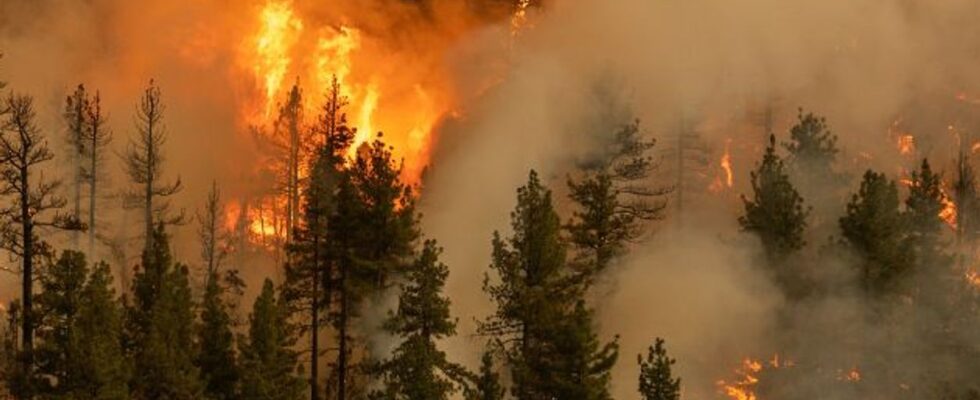The Minister of Ecological Transition, Christophe Béchu, has been insisting for several months on the need to prepare for global warming of +4°C in France by the end of the century. With such temperatures, the hexagon will change radically.
Since the signing of the Paris agreements in November 2016, the figures for limiting global warming to a maximum of +1.5°C – +2°C have been given as an objective by both politicians and scientists. However, in his detailed report on the impacts of rising temperatures in France, Christophe Béchu speaks of a much larger figure: +4°C in 2100. The Minister for the Ecological Transition urges anticipation in this text which is subject to public consultation from this Tuesday, May 30.
Agriculture, transport, housing… The document details the evolution of the climate in the coming decades. At the global level, it is +1.5°C in 2030, +2°C in 2050 and +3°C in 2100qthey are waiting for humanity. But for France, the observation will be higher and faster: +2°C in 2030, +2.7 degrees in 2050 and +4°C, therefore, in 2100. Geographical position, hot air currents, significant emissions… Many parameters explain this increased impact. But behind the figures hides a reality: with +4°C, the face of France will change radically.
What’s next after this ad
Drought and heat wave will be part of daily life
For several years now, periods of drought have come earlier and longer. This year 2023 was marked by the very early arrival of the maximum drought alert in several departments, from mid-May. In 2100, it is to be expected that these will be much more frequent. They could also lengthen by nearly 10 days per year, or nearly 50% more than in the current climate. Some regions will be particularly affected:e south-west, Brittany and all around the Mediterranean.
In summer, an average of +5°C to +6°C will be observed. Heat waves will be continuous for at least two months of the summer season, with heat peaks exceeding 50°C for several consecutive days. These particularly intense waves will also be much more frequentexperts from the IPCC estimate them to be five to ten times more numerous in 2100.
This lack of water will greatly impact daily life. The restrictions will be put in place on a permanent basis throughout the year, and not only in the summer. In cities, infrastructure will be weakened, the walls can crack due to the drought and the foundations break. Transport will also have to reinvent itself to be able to be used with such high temperatures on the ground. Another important side effect: agriculture will be completely turned upside down. Among the foods in danger: corn, soybeans, and wheat.
What’s next after this ad
Rising waters will redefine the contours of the country
By 2100, a rise in sea level approaching 1 meter is expected. This climb will considerably change the French landscape, making some towns uninhabitable. The regions of Dunkirk, Le Havre, Brest, the Poitevin marshes, the mouth of the Gironde, the Arcachon basin, the surroundings of Narbonne or even the Camargue will have their feet in the water. In Dunkirk and Calais, some neighborhoods won’t even be habitable anymorethe others will be very prone to flooding.
This rise in water levels will be aggravated by another change in the face of France: the melting of the ice. Indeed, by the end of the century, all of the territory’s glaciers should have disappeared. The snow will also be much less present. It could even be completely impossible to find in the middle mountains before 2100.
What’s next after this ad
Natural disasters will increase
With these rapid and drastic climate changes on the old continent, natural disasters are likely to increase in number. Several phenomena are pointed out by scientists.
- With the drought, the fire season will be twice as longand very large fires will rage in the north of the country.
- The rains will be more intense and sudden. Coupled with the rising waters, frequent flooding are to be anticipated.
- French territory is generally quite sheltered from strong winds, but with global warming, the situation could change. Scientists warn about certain types of storms which hitherto occurred once a century and which could recur every year. Some areas near the coast would become permanently uninhabitable.
- The spread of viruses will be facilitated. Dengue or chikungunya particularly appreciate warmer climates and these serious illnesses may develop in France.
What’s next after this ad
The first ways to adapt
To cope with the realities of a France at +4°C, several avenues are beginning to be explored by the government. Three major projects occupy the Minister of Ecological Transition. The report unveiled exclusively by the JDD details: “First of all, public services and infrastructure : our roads, our rail network, our telecommunications infrastructure, etc., must be resilient to the new climate deal (…) The second project concerns local authorities and we are working on how to help them cope with these consequences. Finally, the third project is devoted to economic actors: all sectors, from tourism to industry, must gradually adapt. ”
For Christophe Béchu, decisions concerning changes to our way of life should be done collectively: “For example, which road, considered to be of capital importance for a territory, will have to be protected at all costs? Which road will need to be moved? Can we accept that it is flooded once or several times a year?” Once this first stage of consultation has been completed, the report should be taken into account in the third national plan for adaptation to climate change which will be adopted by the end of the year. Faced with the criticisms raised against climate inaction and the far too slow pace of the measures taken by the French government, the minister wants to be reassuring: “it will not just be a collection of good intentions.”
